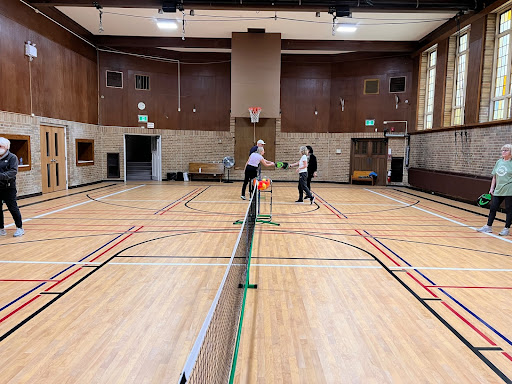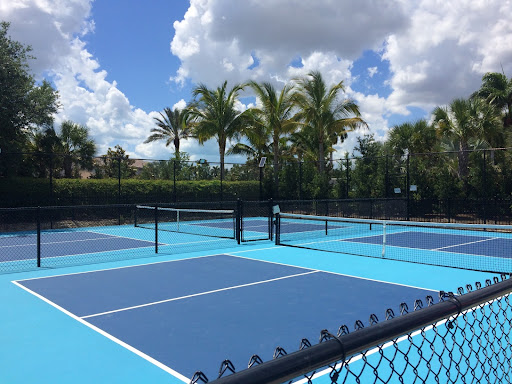Who else has experience playing pickleball on every type of surface possible? If you’re like me and you bring a paddle wherever you go - vacations included - then you’re likely going to come up against a wide range of playing situations, including playing surfaces.
For example, each time I visit the east coast of Canada I visit a new place to play. One year it was Mount Allison University, next year I went to the small town of Shediac (they have great courts by the way) and I also visited PEI for a day… and spent it playing pickleball.
Overall, I’m pretty comfortable jumping into a new environment, knowing basically no one and playing with them. This had me thinking though, not everyone feels this way, so how does one acclimatize to a new environment as fast as possible? Take what you’d like, here’s a bit of my experience and insight from playing in so many different places.

Photo credit: Sara McInnes
When playing indoors, the conditions that can really make a good experience - or go the other way - comes down to things like ceiling height, lighting and ventilation. Playing on an indoor professional court is like a dream come true for those of us who live through snowy winters, but in the summer, if there is a lack of ventilation then it’s a hard pass.
It simply becomes too hot, I’d rather deal with the sun and swirling wind before playing inside a stuffy court. This might come across as too harsh but after my experience playing in so many different places, this is where I’ve landed. Of course, the main factor to any court environment is the playing surface.
Rubberized flooring: if you ever decide to play pickleball at a badminton club, chances are it’s going to be on a rubber floor. While the material is forgiving on the body, I find that the bounce sits lower and the rubber slows down the game ever so slightly because of its grip on the ball. Depending on lighting conditions, the yellow indoor Onix Fuse or orange indoor Onix Fuse is the way to go.
I also recommend indoor, rubber sole shoes - either badminton, volleyball or court shoes. Many of these badminton courts will have dead spots, this is due to the material shifting over time. These pockets have no effect on badminton players, as their birdie is not designed to bounce, but you will find that a ball simply dies off the bounce from time to time.

Photo credit: Sara McInnes
If I had to give a score (1-10, 1 being low, 10 being high), the rubber surface gets a 5/10 simply due to the dead spots.
Hardwood: Get ready for some skipping and by skipping I mean the ball, not you. These floors tend to have a sheen finish on them to protect the wood which can cause the ball to really skid.
The other thing to consider is that when the floors are overused and not cleaned properly the layer(s) of dust will settle and actually cause players to slip quite a bit. I remember attending drop-in years ago at this one facility run by the city and people were using wet towels to wipe off their shoes between points to avoid injury. One other element to consider are the multiple lines on the floor.
This is really common as most schools and recreation facilities have hardwood gyms and there are lines to accommodate multiple sports like volleyball, basketball, etc. Some gyms have begun to include lines for the non-volley zone and others will continue to use the badminton service line (which is a couple of inches short) of a regulation “kitchen”.
I know people who are quite distracted by these lines, my feeling is that over time you sort of get used to it and it’s not too hard to identify the parameters of a pickleball court. Where it does get tricky is making those line calls, if the ball bounces in an area where lines are overlapping some questionable calls happen, but it’s just the nature of the environment.
For shoes, I’ve used both indoor and outdoor court shoes. I’ve actually rolled my ankle using outdoor shoes so if I’m ever playing on hardwood, I lean on my indoor shoes. This surface material scores a 6.5/10. The ball has a truer bounce on hardwood than it does on the rubber.

Photo credit: Sara McInnes
The next three different types of playing surfaces can be found inside and outside. So, certain variables that will change the environment are the natural outdoor elements and the typical indoor elements as previously mentioned.
Concrete: I’ve had plenty of experience playing on this surface, most concrete pickleball courts are on hockey rinks. I will say that outdoor rinks tend to have a grittier surface and I don’t mind playing on this surface at all.
The most challenging thing with this option is that after it rains, the rink will take a while to dry - whoever designed the modern day hockey rink did a great job retaining water.
However, indoor concrete is a different breed. Canadian Nationals 2019 and 2022 were both held in Kingston, Ontario and they used a hockey rink surface both times. Although a hockey rink can accommodate many courts (there were 7 courts for every ice pad for a total of 28), the main concern with this surface is the wear and tear it takes on the body due to the solidity of the material.
Unlike rubber and even hardwood, concrete is just so unforgiving. If the floors have been sprayed with a finish then they’ll be less slippery but otherwise the concrete will most likely be extremely slippery.
My recommendation with this surface is to bring a wet towel to wipe off the shoes, as a precaution; both indoor and outdoor court shoes seem to be fine. The best thing this material has going for it is that it’s very level and has little imperfections that will affect the bounce of the ball - and - you can use any type of ball. Outdoor rinks get a 7/10 but unfortunately, indoors this surface gets a 4/10 in my books.

Photo credit: Sara McInnes
Clay: This is a far less common surface to play pickleball but it’s been done before and will continue to be used. While it’s true, the crushed, sand-like material causes a lot of… interesting bounces, the surface is very fun to slide around on.
If I’ve got my facts right, clay is the red material and the grey or green clay is called Har-Tru. I’ve only played on Har-Tru, so I can’t speak to the exact differences between the two but I imagine that they are finite.
With the limited experience I have with this surface, it requires someone to refresh the lines after every 3-4 games. I recommend using a softer, outdoor ball such as the Penn 40 or Onix Pure 2; and for shoes I’ve used my multi-surface (specifically designed for multi surface) court shoes. Given that this clay has strong pros and cons, I have to score it a 5/10.

Photo credit: Sara McInnes
Hardcourt: The Holy Grail of all surfaces and what every serious pickleballer dreams of! Where I live we actually have no dedicated indoor hardcourt pickleball courts. I think the closest to me is about one hour away.
There are a few hardcourt outdoor courts, which of course are in constant high demand. The ball bounces perfectly on this surface and it provides ample grit so that you’re not slipping or having issues pushing off in a certain direction, so the only factors you have to consider are the surrounding ones, like how tall are those palm trees…

Photo credit: Sara McInnes
Highly recommend outdoor court shoes only, the grit will chew up the soft rubber of an indoor shoe. The same goes for balls, outdoors only as the indoor ball simply won’t last on this surface. It’s an obvious 10/10 for me on this one.
Now for the only surface I’ve yet to come across outside and not inside…
Asphalt: This classic material is like a mash up of Har-Tru and concrete. Because of the tiny pebbles, you tend to slip all over the place. There’s this set of asphalt courts near me and I think everyone who’s used it sort of describes it as bouncy, somehow this asphalt has additional spring to it and the ball sort of flies off of the ground.
I’ve played lots of pickleball on this surface so I’m going to give it a bit of love despite its downfalls. 6/10, maybe 7/10 on those dedicated courts (picture below), definitely stick to the outdoor ball and outdoor shoes.

Photo credit: Sara McInnes
For many of us still, beggars can’t be choosers and there are a lot of us begging for more pickleball. I’ll continue to play on any surface, coach on any surface and the only time I will get particular is leading up to a tournament. Practicing on the same surface with the tournament ball is the best way to prepare for competition. Otherwise, I’ll go where the games are.
This article was taken from our 'Control the Kitchen' Newsletter, if you're interested in receiving more content like this, please feel free to sign up using the subscribe section located at the bottom left of this page (or underneath the article if you're on mobile), thanks!